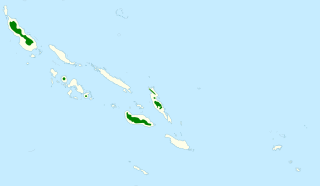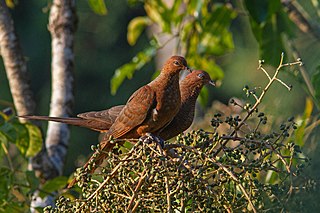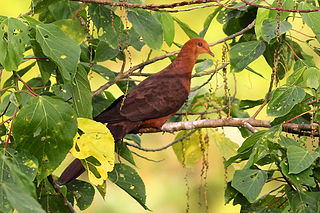
The Amboyna cuckoo-dove is a dove in the genus Macropygia found in the Moluccas and New Guinea. It was one of three new species defined when the slender-billed cuckoo-dove was split up in 2016 and retains the Latin binomial of the former species.[1]

Wallace's fruit dove is a species of a bird in the pigeon family Columbidae. The name commemorates the British naturalist Alfred Russel Wallace. It is a rather large, long-tailed fruit dove with a length of 24–28 cm (9.4–11.0 in) and has been described as "one of the most beautiful" fruit doves. The forehead and crown are dull crimson, the lower face and throat are white, and the rest of the head, breast, neck, and upper back are pale bluish-grey. The wings and lower back are green and the belly is orange, separated from the chest by a white band. Both sexes look similar, but females have less extensive red on the head and a greenish tinge to their grey parts.

The pale mountain pigeon is a species of bird in the pigeon family Columbidae. It is endemic to the Solomon Islands archipelago, where it inhabits old-growth and secondary montane forest. It is a medium-size pigeon with an average length of 38 cm (15 in) and a weight of 310–385 g (10.9–13.6 oz). The head and neck are whitish-grey, the belly and lower breast are buffy-pink, and the vent and undertail coverts are pale grey. The upperparts are smoky-grey with darker fringes on the mantle and wing coverts. Both sexes look similar, but there can be large variation in individual appearance.

The ruddy cuckoo-dove is a species of bird in the family Columbidae. It is a medium-sized, reddish brown cuckoo-dove, found in Brunei, Indonesia, and Malaysia. It is rated as a species of least concern on the International Union for Conservation of Nature Red List of Endangered Species.

Macropygia is a genus of bird in the pigeon and dove family Columbidae. The genus is one of three genera known as cuckoo-doves. They are long tailed, range between 27 and 45 cm in length and have brown plumage. The genus now ranges from India and China through Indonesia and the Philippines to Vanuatu and Australia, though they originated from North and South America.

Mackinlay's cuckoo-dove, also known as the spot-breasted cuckoo-dove, is a species of bird in the family Columbidae. It is found in Papua New Guinea, Solomon Islands, and Vanuatu. It is rated as a species of least concern on the International Union for Conservation of Nature Red List of Endangered Species.
The bar-tailed cuckoo-dove or black-billed cuckoo-dove is a species of bird in the family Columbidae. It is native to New Guinea and the Bismarck Archipelago. It is rated as a species of least concern on the International Union for Conservation of Nature Red List of Endangered Species.

The little cuckoo-dove is a species of bird in the family Columbidae. It is a reddish brown pigeon, and is found in Brunei, China, Indonesia, Laos, Malaysia, Myanmar, Thailand, and Vietnam. It is rated as a species of least concern on the International Union for Conservation of Nature Red List of Endangered Species.

The Andaman cuckoo-dove is a species of bird in the family Columbidae. It is endemic to the Andaman and Nicobar Islands. It is characterized by its small body and rusty color. Its call is a repeated cooing "koo". Due to habitat loss and hunting, the species is becoming rare, yet it is listed as Least Concern. The Department of Environment and Forests, Andaman and Nicobar Islands, and the Zoological Survey of India are monitoring, surveying, and bringing awareness to the species’ population. The species is frequently discovered in or around forest areas, with a diet that consists of mostly fruits and berries. The Andaman cuckoo-dove’s breeding season is believed to be from February to April, but little information is known about this species.

The Philippine cuckoo-dove is a species of bird in the family Columbidae. It is found in the Philippines and Taiwan and is rated as a species of least concern on the International Union for Conservation of Nature Red List of Endangered Species.

The barred cuckoo-dove is a bird species in the family Columbidae. It is native to South and Southeast Asia, and listed as Least Concern on the IUCN Red List.

The amethyst brown dove is a species of bird in the family Columbidae.

The scarlet-breasted fruit dove is a species of bird in the family Columbidae. It is endemic to Indonesia, where it occurs in the northern Moluccas. Its natural habitat is subtropical or tropical moist lowland forests. It is rated as a species of least concern on the International Union for Conservation of Nature Red List of Endangered Species. In 1863 Hermann Schlegel named the new species for one of his collectors, Heinrich Agathon Bernstein.

The pied cuckoo-dove is a species of bird in the pigeon family, Columbidae. First described by English zoologist Philip Sclater in 1877, it is endemic to the Bismarck Archipelago, where it mainly inhabits lowland and hill forests at elevations of up to 1,000 m (3,300 ft). It is a large, distinctive pigeon, with a length of 40–46 cm (16–18 in) and a weight of 279–325 g (9.8–11.5 oz). Adults are mainly black and white. The heads and underparts are whitish, while the wings, tails, and upperparts are black. Both sexes look alike. Juveniles are mainly sooty-grey in colour.

The great cuckoo-dove is a species of bird in the pigeon family, Columbidae. First described by the Dutch zoologist Coenraad Jacob Temminck in 1824, it is found on New Guinea, several surrounding islands, and Wallacea, where it mainly inhabits primary forest and forest edge. It is a large, distinctive pigeon, with a length of 47.5–52.5 cm (18.7–20.7 in) and a weight of 208–305 g (7.3–10.8 oz). In adults, the head, neck, and breast are whitish or blue-grey, the underparts are pale bluish-grey, the upperparts are chestnut-brown, and the outer wings are black. Females differ from males in having more yellowish irises and duller orbital skin. Juveniles are mainly dull grey-brown, with dirty-white throats and bellies.

The black cuckoo-dove or black dove, also known as the slaty cuckoo dove, is a species of bird in the family Columbidae. It is endemic to the Lesser Sunda Islands, being found on Timor, Wetar, Rote, and Atauro. It inhabits primary and secondary monsoon forest, eucalyptus forest, and woodlands. It is 38.5 cm (15.2 in) long on average and is mainly dark bluish-gray, lighter on the head and underparts and darker on the wings and tail. It has yellow orbital skin.

The brown cuckoo-dove is a dove in the genus Macropygia found in Australia from Weipa and Aurukun in the north to Bega in the south, and most inland at Atherton and Toowoomba. It is sometimes called the "brown pigeon" or "pheasant pigeon", but both terms are best avoided, as they can lead to confusion with the brown doves and the true pheasant pigeon. It was one of three new species defined when the slender-billed cuckoo-dove was split in 2016.
The bar-necked cuckoo-dove, also called the duskycuckoo-dove was split into the following species in 2016. The name "bar-necked cuckoo-dove" remains valid when used to describe the Macropygia magna species complex as all of its members have barred necks and breasts.
The Tanimbar cuckoo-dove is a species of bird in the family Columbidae. It is endemic to the Tanimbar Islands in Indonesia. It was previously grouped together with the Timor cuckoo-dove and the Flores Sea cuckoo-dove as the dusky or bar-necked cuckoo-dove.
The slender-billed cuckoo-dove was until recently the name of a species of bird in the family Columbidae. Its range covered Brunei, Indonesia, Malaysia, Papua New Guinea and northern Australia. The binomial M. amboinensis now refers to the Amboyna cuckoo-dove. The taxonomy of the slender-billed cuckoo-dove was complex, but most authorities now split it into four species based on analyses of vocalizations. This will be further refined by future genetic analyses.

















